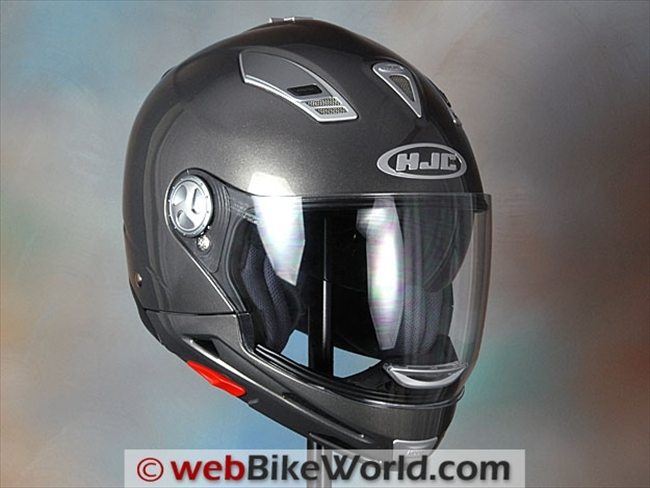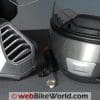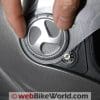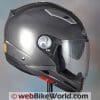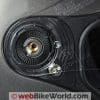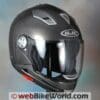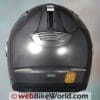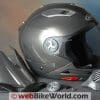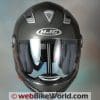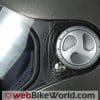HJC IS-Multi Motorcycle Helmet Review
The HJC IS-Multi is an interesting modular helmet that can be easily converted from a full-face to six other helmet types.
The question is, do you need a 7-in-1 helmet?
HJC now claims to be the “#1 in the World” and they didn’t get there by resting on their laurels.
The company keeps a relentless pace of new helmet designs, more so than probably any other motorcycle helmet manufacturer.
The prices are right and the quality is too and they have an excellent distribution system that puts HJC helmets in just about every motorcycle dealer on the planet. Surely, a recipe for success.
The HJC IS-Multi is their newest design and, we think, a fairly radical departure from the “normal” motorcycle helmets that compose the bread and butter of the HJC lineup.
The IS-Multi is proudly proclaimed to be a “7-in-1” helmet because it can convert from one form to another with relative ease.
As illustrated on the the face shield protective film used on the helmet, the IS-Multi can convert from:
- A full-face to a Supermoto (adventure touring) helmet.
- An off-road helmet.
- An open face “Jet” style helmet.
- A standard open face with face shield.
- A trials helmet and an open face with no face shield.
Mix and match a few of the extra parts that come with the IS-Multi and you may even be able to morph it into two or three other different helmet types — although it depends on your definition of the word “different”.
In reality, I think the full-face guise works best and I’m actually not too sure how often the IS-Multi would be converted to other helmet types, especially the “Classic” open-face form with no face shield.
The IS-Multi does make a decent Supermoto or adventure touring helmet with the easy addition of the included peak and it also looks not at all bad as a trials helmet.
In fact, it’s one of the only modular helmets that does look the part in each of its converted forms, unlike other modular helmets we’ve reviewed that seem a bit odd in one or another of their conversions.
One question comes immediately to mind though: Do you really need a helmet that can convert from one form to another? I’ll leave that up to our readers to answer in our poll at the end of this review.
But before you answer, read on, because a helmet that can be converted to this many different designs requires a lot of thoughtful engineering, and I had a few issues with some of the parts that are necessary to make the IS-Multi what it is.
Note that rather than try and evaluate the IS-Multi separately for each of its 7 configurations, I will review it as a full-face helmet and refer to other configurations as necessary.
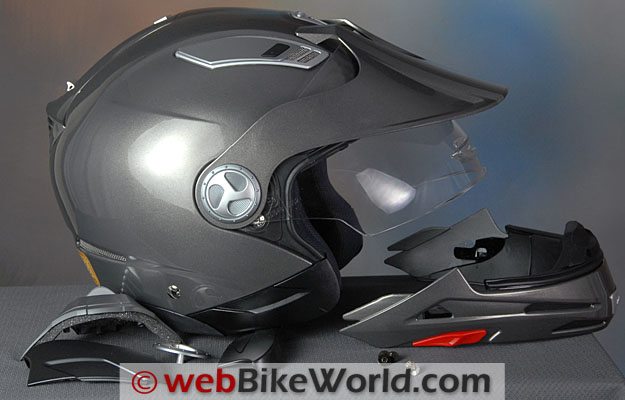

HJC IS-Multi Paint, Graphics and Overall Quality
The metallic charcoal/taupe colored paint on this IS-Multi looks perfect and the depth of color and finish is outstanding.
The clear coat seems thick and has a “hard” feel, although not quite as shell-like as the Hi-Brite finish used on helmets like the the Nolan N90 (review) or the Caberg Sintesi (review).
The metalflake or metallic bits are larger than usual and looks exceptionally nice on this particular helmet, giving a depth to the finish and a very nice glint in the sunlight.
Overall, the fit of the parts is excellent, although the helmet shell, even with the removable chin bar installed, does seem to have more flexibility than comparable flip-up helmets. It’s more akin to the flexing that might be found in an open-face helmet.
The chin bar removes by pulling back sliding tabs on either side and it is a bit fussy on this helmet; or at least it’s a bit fussy to replace the chin bar, as it’s somewhat difficult to line up the slots on either side when the helmet is not being worn.
I’d like to see a more robust design for the chin bar, because it doesn’t quite have the solidity that would make me feel more comfortable that it will protect in a crash.
But the liner material, the padding, the operation of the vents and the other normal helmet moving parts all seem to be well made.
Quality of the Convertible Parts
In one sense, the IS-Multi is a well-thought-out design, in terms of its ability to convert from one helmet form to another.
The round plastic attachment knobs (don’t know what else to call them) on either side of the very large clear face shield unscrew easily from the helmet.
They feature aluminum screws and brass threaded inserts in the helmet shell and the operation of the screws is smooth, so they hopefully will not cross-thread or strip.
The helmet comes with one additional round knob, so it may be possible for the knobs on the helmet to come unscrewed with vibration or somehow lost by the owner.
The knobs are screwed in to the helmet shell until they are tight; there’s nothing that holds them or that indicates when they’re tight enough or too tight. Just remember that these aren’t hardened steel but aluminum, brass and plastic, so snug is probably good enough.
The helmet also comes with one additional metal screw of the type that can be seen in the photos, just below and to the front of the large round knobs on the side.
I’m not sure why HJC included an extra screw of this type, because this isn’t a screw that needs to be removed to convert the helmet and it doesn’t seem like it would easily pop out of the helmet shell.
The IS-Multi also comes with a peak that can be fitted to the top of the helmet to convert it to an adventure touring or trials type or an open-face with peak.
The peak seems just a bit thin and too flexible to me; I’d feel more comfortable if the plastic used in the mold was perhaps another millimeter thicker.
It easily fits on to the helmet underneath the threaded knob holders and simply sits on the top of the helmet with no additional attachment, held in place only by the threaded knobs on either side of the shell.
The chin bar comes with a small plastic insert with the word “Multi” molded in, as can be seen in the photos. This part is held by a single self-threading screw and a washer that fits in a recess in the padded chin bar.
This to me is the most disappointing aspect of the helmet, because the metal screw threads into the plastic molded insert.
The insert is designed to be removed and replaced with a faux chin bar vent appliqu� that uses the same single screw on the bottom inside the chin bar and two additional screws (supplied in a plastic bag) in the top.
Screwing these in and out is difficult because the screws fit into recesses in the chin bar padding and it’s difficult to get the screws lined up correctly.
I immediately stripped the plastic threads that hold the “Multi” emblem.
And, since the faux chin bar vent is non-functional anyway, I suggest not using it at all. This soured my experience with converting the helmet back and forth and I do think HJC should have used brass inserts here also.
Score: I’ll give the IS-Multi an “Excellent” rating for overall quality, paint and liner but a “Poor” rating for the replaceable bits.
After all, in a helmet that is designed to be converted to 7 different forms, the removable parts and threads and screws should be designed for many uses over the life of the helmet and, quite honestly, none of these removable and replaceable parts feel like they will hold up for more than a few conversions.
HJC IS-Multi Helmet Fit, Internal Shape and Liner
The IS-Multi has what I’d classify as a near-standard “neutral” fit that should work for the vast majority of rider head shapes.
The top of the helmet is very slightly biased towards the narrow side of neutral and the helmet feels like it tapers down slightly on either side at the lower parts of the cheek pads.
I can wear it for about 45 minutes or so before it gets slightly uncomfortable around my lower jaw, so riders with a round head like me or large jaws may need to go to a thinner set of cheek pads, if such exist and are sold separately for the IS-Multi.
Otherwise, the liner and padding feel very comfortable and the material, I must say, is more comfortable than the new Arai RX-Q that is also in the process of evaluation for an upcoming webBikeWorld.com review.
The quality of the liner and material in the IS-Multi seems very good.
The size large shown here is perhaps about 1/2 size larger than expected and it should fit a 60 cm to 61 cm head. The liner and cheek pads are removable.
The helmet shell does seem larger at the top than average, giving the helmet (and my head) a partial case of the “fishbowl effect”. The size large helmet uses the larger of the two shell sizes, which may help to make the IS-Multi feel slightly top-heavy.



More information on helmet fit can be found in the webBikeWorld Motorcycle Helmet FAQ page, along with the chart that lists the helmet weights of webBikeWorld reviewed helmets and also by shape on the webBikeWorld Motorcycle Helmet Shapes page.
Score: I’ll give the IS-Multi an “Excellent” for a neutral fit and better-than-average comfort in the liner and liner fabric.
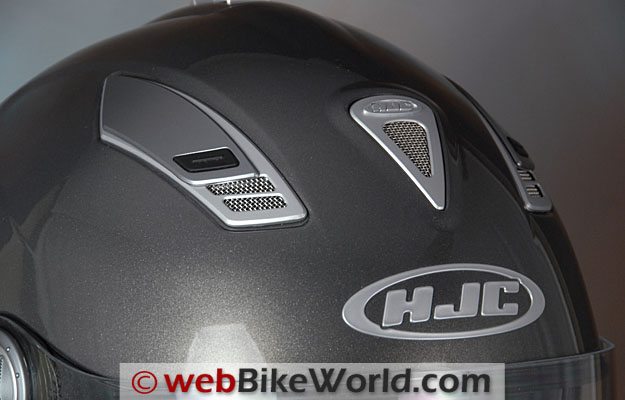


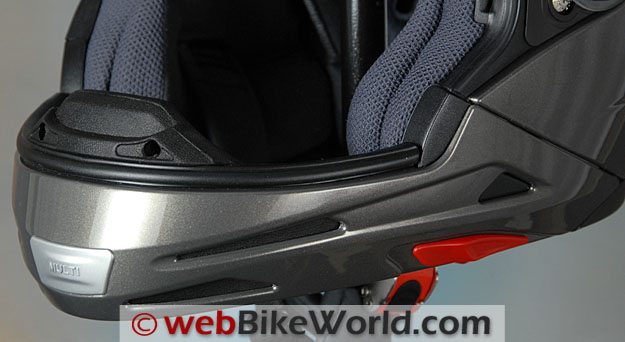


HJC IS-Multi – Face Shield, Eye Port and Visibility
The IS-Multi works best in its full-face guise, in my opinion. The best part is the absolutely huge face shield — if only all full-face helmets would provide such fantastic visibility!
And if the IS-Multi meets ECE helmet safety standards, which it does, then why do other full-face helmets have such comparatively tiny eye ports?
I actually found myself looking in the rear-view mirror on the motorcycle to make sure the helmet was actually on my head and fitted properly, because when I’m wearing it in full-face mode I can’t see the sides nor the top in my peripheral vision.
The view of the road ahead is superb, and this alone must be a critical safety factor.
The clear face shield, which is claimed to offer 95% UV protection and an anti-scratch coating, has four detents and it does not have a first opening for defogging.
But none is needed actually, because a lot of air comes up from underneath the thin chin bar to provide ventilation, whether it’s needed or not.
The chin bar does not have a vent but there is a small window in the bottom of the face shield that can be opened or closed and which acts as the chin vent.
It doesn’t really do much and I can’t feel any difference whether it’s open or closed because of the large volume of air from underneath. I’m rather surprised that with all the other parts that HJC didn’t provide a chin curtain to go with the chin bar.
The IS-Multi uses the standard HJC system for its internal rotating sun visor, and unfortunately this is one of the least-liked sun visors we’ve found. It is an on/off only device that is spring-loaded, so it can’t be stopped in an intermediate position to help with overhead glare.
Also, to engage the sun visor, the rider must reach all the way in back of the helmet and pull the lever forward and up.
The spring-loaded release button is right at the top of the travel, so all too often when wearing gloves, the too-sensitive release button is pressed by accident just when the sun visor engagement lever reaches the top of its travel, which then springs it back up into the helmet.
The design is just too fussy and, I think, over-engineered; a simple friction device with an engagement lever on the side would be easier to use and probably weigh less.



The internal sun visor also has a highly scalloped lower edge that remains in the rider’s line of sight when fully lowered, which is annoying. Overall, not a good design in my opinion.
Score: I’ll give the IS-Multi an “Outstanding” for outer visibility, but a “Poor” for the lack of chin ventilation options and the design of the rotating sun visor.
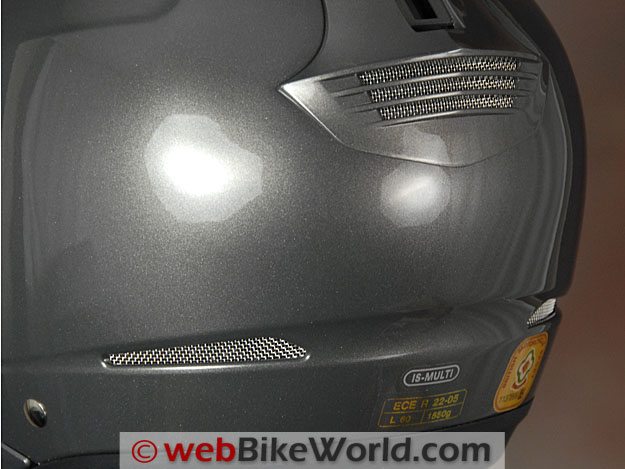


Ventilation and Air Flow
The top vents of the IS-Multi have a modern look. The vent covers are sliders with a smooth feel and they can uncover one or two of the metal screen-filled slots. The air flow they provide is slightly better than average.
The helmet also has an exhaust port built in to the rear of the internal sun visor assembly on top of the helmet, along with a pair of exhausts located at the lower edge of the helmet in the rear. All told, this system does a good job at upper ventilation.
I discussed the chin bar ventilation above; basically there are no options and the air flows up underneath the chin bar. It would have been nice if HJC included a chin curtain to help control the air flow from under the helmet.
The large face shield has a small window that can be opened but its additive effect is minimal at best.
So I’m not sure how well the IS-Multi will fare during winter weather; I’m afraid it will have too much air flow in the front, making it a warm-weather helmet only. Of course, this is all in relation to the IS-Multi in its full-face configuration.
Using the helmet as an open-face means nearly unlimited ventilation at the lower part of the helmet.
Using it as an off-road helmet means no face shield and replacing the appliqu� on the chin bar with the fake motocross helmet “vent” does nothing to change the air flow through the chin bar itself.



Score: I’ll give the IS-Multi an “Excellent” rating for the upper ventilation system but a “Poor” for inability to control the air flow at the lower part of the helmet.
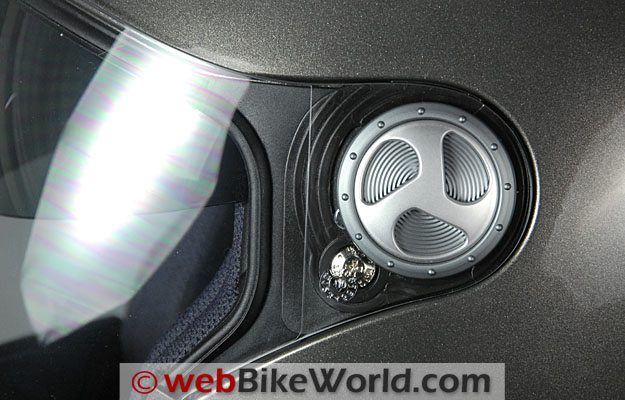


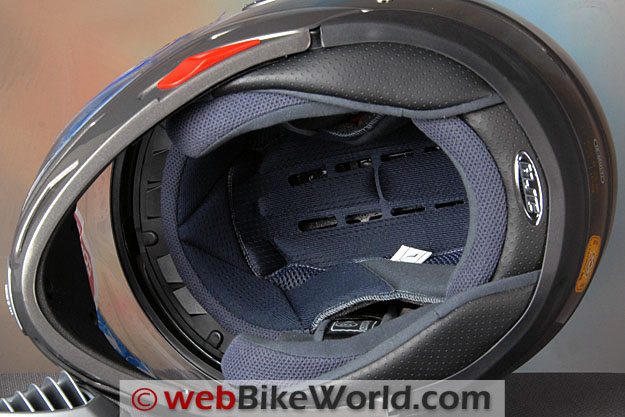


HJC IS-Multi Sound Levels
As you can see by my hot/cold scores so far, it’s difficult to rate the IS-Multi, and that goes for noise control also.
The upper vents and the upper part of the helmet actually seem relatively quiet, but the lower part of the helmet seems to generate a lot of noise, mostly due to the uncontrolled air coming in under the thin chin bar.
This noise is apparent whether riding a motorcycle with or without a windscreen, and it’s very loud when riding any type of motorcycle with a windscreen or fairing that directs the air on to the mid- to lower part of the helmet.
Again, I think a nice chin curtain would help eliminate this problem.
Again, the perceived noise levels will vary greatly, depending upon which helmet configuration is being used.
Open-face helmets are usually much louder than full-face helmets, especially in the amount of noise generated around the bottom of the helmet, although this will vary depending upon the rider and motorcycle type.



Note that our helmet evaluations are a combined effort of several riders over time on different types of motorcycles with and without windscreens.
Evaluators wear correctly fitted, high quality ear plugs (even when evaluating motorcycle intercom systems).
Always protect your hearing when riding a motorcycle. See the wBW Earplug Reviews for more information on choosing and wearing earplugs.
Note also that perceived noise levels will vary, depending on the individual.
Noise can be caused by many factors, including helmet fit, the type of motorcycle and windscreen, wind speed and direction and even the rider’s clothing.
For more information on helmet noise, visit the wBW Motorcycle Helmet Noise page.
Score: I can only give the IS-Multi a “Poor” rating for noise control.
Helmet Weight
The IS-Multi shown here in size large weighs a relatively light 1560 grams (3 lbs. 7 oz.) in its full-face configuration.
The chin bar weighs 179 grams (6-3/8 oz.) and the other parts have minimal to no effect on weight.
This makes the IS-Multi one of the lightest flip-up or modular helmets we’ve reviewed. Note that we define a flip-up as a helmet with a rotating chin bar.
A modular helmet is defined as a helmet that can be converted from one form to another; examples include the IS-Multi, the Shark Evoline (review) and others.
Other than the slight top-heavy feel noted above, the IS-Multi is well balanced and the fit and comfort is fine.
For more information on helmet weights, see the wBW Motorcycle Helmet Weights page and the chart that lists the reviewed helmets by weight and shape on the wBW Motorcycle Helmet Shapespage.
Miscellaneous
The HJC IS-Multi meets ECE safety standards for full-face and open-face helmets. It is unknown whether the helmet will be sold in North America.
UPDATE: Note from the U.S. distributor for HJC: “HJC was showing (the IS-Multi) at the Indy show last February and it has a good fit, and multiple configurations.
There have been talks of bringing it to the states, however I don�t believe they (HJC) received the warm reaction / feedback they were looking for at the trade show to justify adding it to the line.
At this time it is only a Euro release with no plans of it being offered here. Should anything change I will let you know.”
The helmet shell is made from polycarbonate. The chin strap uses the micro-lock system and features a separate D-ring to lock the helmet to a motorcycle.
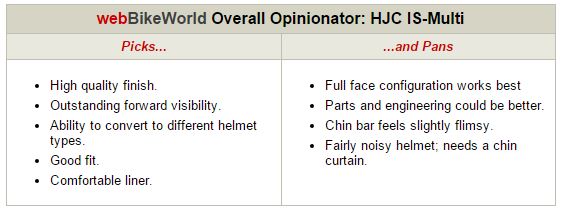


Conclusion
The HJC IS-Multi is certainly an interesting helmet design and we have to give HJC credit for pushing the envelope. The question remains whether this is just a novelty or if the various configurations will actually be used by owners.
In its full-face configuration, the IS-Multi provides outstanding forward visibility, which in and of itself may be a reason to own the helmet.
It has other useful features beyond its modular capabilities which make it a desirable helmet regardless of its ability to convert to some of the other forms, some of which may never be used in any case.
In the end, I have mixed feelings about the IS-Multi. I do wish that some of the removable parts used for the various conversions and the engineering of the systems felt more robust.
I’m rather surprised that a helmet designed to convert to various formats doesn’t have higher-quality parts.
Would I buy one for myself?
Well, disregarding the fact that I already have done so, I’ll probably stick with “normal” full face helmets for now.
I am interested in hearing from IS-Multi owners though to get their thoughts and especially to learn how they are using the helmet.
| wBW Review: HJC IS-Multi Helmet | |
|---|---|
| Manufacturer: HJC Europe | List Price: £170.99 |
| Colors: Solids and metallics. | Made In: Korea |
| Sizes: XS-XL Shell Sizes: Two (XS-S and M-XL) |
Review Date: August 2010 |
|
Rating Scale is subjective: Unacceptable, Poor, Neutral, Very Good, Excellent, Outstanding.
|
|
Owner Comments and Feedback
See details on submitting comments.
From “R.S.” (September 2011): “I found this helmet at a dealer and was instantly interested to buy one. After haven’t ridden a motorcycle for 15 years, this year I bought myself a Yamaha MT-01.
Thinking, large and powerful (torque) bike, great for relaxed riding (open faced helmet) and occasional sporty riding (full face).
I have used it now for a couple of months and am regularly changing from open face to full face. Not being used to modern day helmets, I can not tell if the helmet is noisy in comparison to other helmets. Lately I use ear plugs, so noise level is reduced anyway.
The helmet is fairly comfortable, in both open and full face, surely in comparison to my second HJC, full face helmet, which with the same size is very tight around the cheeks. Noise is the same level.
I have already noticed the removable inner lining is slightly damaged. The chin piece and retractable dark visor look and feel a it flimsy, as if they are not part of the helmet. Other than that I am moderately satisfied with the helmet, until last weekend.
Because of the warm weather and my intension of some relaxed riding I had converted the helmet to open face.
Next day, cold morning, I wanted to convert back to full face and to my disbelieve one of the large knobs that fix the visor, would not come loose.
After several attempts It finally came loose only to discover that the screw tread was broken leaving a part in the helmet. This weekend I will go back to the dealer and wait what they will say.”
From “W” (06/2011): “I would like to inform you about one very important aspect in regard to modular helmets. Short introduction about myself. I’m a photographer. More in detail a cycling photographer.
So when sitting on the back of a motorbike during a cycling race, makes working only possible with a helmet that’s even less then a open face helmet. No visors sticking out, or what so ever.
But, I’m also a motorbike rider. So how do you travel with a minimalistic helmet on a highway? Simply not possible. The solution, modular helmets that leave no parts sticking out somehow. Like the Scorpion Exo-900, or the HJC Multi.
The last one was my first. But the parts broke, now I have the first one.
In your article of the Scorpion helmet you mention and I quote :
“Unfortunately, other than the internal rotating sun visor, the helmet does not have a separate clear face shield that can be used when it’s in open-face mode. This somewhat limits the usefulness of the conversion, working best for the aforementioned touring riders when they’re riding a motorcycle with a large windscreen to block the wind.”
This is just the ideal future for us photographers to have a multi purpose helmet like this.
Once the flip-up part is removed, the helmet is ready and as minimalistic as we want it. The loose part that comes with it, well that’s worthless for us. For people like me, these types of helmets are very useful, and just the answer not to have to travel with more helmets then pleased.
All my best, and keep up the good work.”
Editor’s Reply: The Shark Evoline (review) might be a good solution, it is a high-quality helmet and when the visor is rotated all the way to the rear, it remains out of the way and is relatively streamlined. Also, you don’t have to worry about losing the parts.


